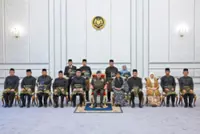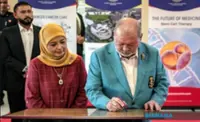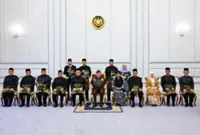The Keris Pendek Diraja is made out of steel sourced from old daggers and features a hilt and sheath made of ivory and engraved in gold.
SYMBOLISING splendour, authority and supremacy, His Majesty Sultan Ibrahim, King of Malaysia, and Her Majesty Raja Zarith Sofiah, Queen of Malaysia, would be seen donning the grand royal regalia during the installation ceremony.
Since independence, the royal regalia has been passed down from one Ruler to another and has been used on many occasions for generations – this includes His Majesty’s father Almarhum Sultan Iskandar Sultan Ismail, who was King 40 years ago.
From wars to hunting and even travelling, historical records showed that the Malay Rulers took their royal regalia along and among the most revered items deemed symbolic are the weapons, attire and sceptres.
And today, during the installation ceremony, a Ruler that has been chosen to be the King of Malaysia would wear the official ceremonial attire known as Muskat.
His Majesty will don the Muskat alongside with the Royal headdress, a buckle and a short dagger making up the royal regalia.
Inspired by the traditional outfit of the people of Oman and Kedah’s baju sikap, Muskat is the official attire of the King worn only on certain occasions which include the installation ceremony, His Majesty’s birthday, during his official visit to Malaysian states and the opening of parliament sessions.
According to Istana Negara, it was first introduced by the third Yang di-Pertuan Agong, Almarhum Tuanku Syed Putra Almarhum Syed Hassan Jamalullail, during his installation ceremony in 1960.
The tradition continues to this day. Another item is the royal headdress known as the Tengkolok Diraja, which is made of black songket and embroidered with gold thread.
For centuries, the Malay Rulers have worn the royal headdresses as part of tradition.
The Tengkolok Diraja is folded and tied in the “Dendam Tak Sudah” style originated from Negri Sembilan. Its style is inspired by the elective monarchy system.
The style of the royal folding varies depending on the tradition of the royal family of each royal house.
Affixed at the front of the royal headdress is an ornament – made from platinum – in the shape of a crescent and a 14-pointed star with Malaysia’s coat of arms in the centre.
Another part of the King’s ceremonial attire is the Pending Diraja (Royal Waist Buckle) and the Keris Pendek Diraja (Royal Short Dagger).
The buckle is made of pure gold and decorated with rubies with an engraved centrepiece featuring Malaysia’s crest.
The belt is made of ribbed silk and features floral motifs embroidered in gold thread.
The Keris Pendek Diraja is made out of steel sourced from old daggers and features a hilt and sheath made of ivory and engraved in gold.
Its hilt, known as the Hulu Pekaka, is shaped like the head of the legendary garuda bird.
Like the Keris Panjang Diraja (Royal Long Dagger), the Keris Pendek Diraja is only worn by the Yang di-Pertuan Agong.
The Keris Panjang Diraja’s hilt and sheath are covered in gold with the emblem of Malaysia and that of the 11 states of Peninsular Malaysia engraved on the cross piece.
The blade is forged from steel taken from 11 keris from all 11 states and the hilt is shaped like a horse’s hoof. It features decorations similar to the jering fruit.
The royal regalia also includes the royal sceptres, namely Cogan Alam (Sceptre of the Universe) and Cogan Agama (Sceptre of Religion).
Cogan Alam is a silver mace measuring 162.66cm in length.
At the head of the mace is an orb on which is a crescent and a 11-pointed star made of gold are surmounted, symbolising Islam as the main religion of the country.
The orb is also decorated with the crests of the 11 states in the peninsula. These are also made of gold and supported by four tigers which symbolise national bravery.
The shaft itself features six stalks of padi carved in gold. Meanwhile, Cogan Agama is 155.04cm long and made of silver.
It consists of a large, conical head with a five-pointed star made of gold mounted on a long shaft. Quranic verses are embossed on the head and shaft.
For the Raja Permaisuri Agong, the unique royal regalia include the Gendik Diraja (Royal Tiara) and Kalung Diraja (Royal Necklace).
The Gendik Diraja is made of platinum and encrusted with diamonds, featuring the traditional awan larat motifs.
Set at the centre of the tiara is a crescent and a star, also made of platinum. The tiara was specially designed so that it can be taken apart to form a locket and brooch.
The Royal Necklace, which is also made out of platinum and fully studded with diamonds, can also be taken apart to form a pair of earrings and ear studs, as well as a brooch.
Other royal regalia items include the Cokmar, Pedang Diraja (sword), Keris Panjang Diraja (long dagger) and Sundang Diraja (a type of dagger).
The Cokmar, a symbol of the power and authority of the Malaysian government, consists of a pair of maces featuring a short staff and a dome-shaped head made of silver. Each mace is an estimated 81.32cm in length.
The Keris Panjang Diraja and Sundang Diraja have carved silver-coated hilts and sheaths. Other symbols of royalty that play an important role at official ceremonies are the seven-metre long Payung Ubur-Ubur Kuning (Yellow Dome-Shaped Umbrella) and Tombak Berambu (a type of spear).
The umbrella is made of yellow silk – the royal colour – and features a 11-pointed star and crescent on its top. The blade of the Tombak Berambu is forged from the metal of ancient spears used all over the peninsula.
The coronation would also see an incorporation of the royal couple’s favourite colour – Tiffany Blue – in various aspects such as the invitation cards and programme book for the ceremony.








